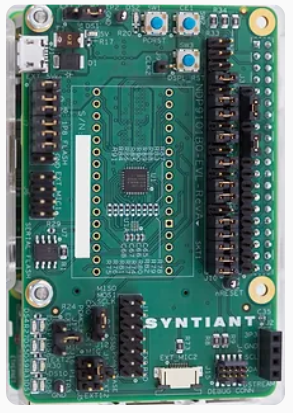The Syntiant® Neural Decision Processor™ (NDP) architecture is built from the ground up to run deep learning algorithms for speech recognition. By utilising highly coupled computation and memory, these devices achieve approximately 100x efficiency improvement over stored program architectures such as CPUs and DSPs, with package sizes down to 1.4 x 1.8 mm.
The NDP101 system-on-chip comes in a 32-pin QFN package where eight of the GPIO pins have programmable direction and drive strength. There are dual inputs for PDM microphone or PCM-over-SPI, and the stereo/mono I2S interface is multiplexed with PDM. The embedded processor is an Arm Cortex-M0 with 112 kB SRAM, and integrated clock multiplier and dividers support low-frequency clock source or external clocking. With active power consumption of <140 µW while recognising words, this device can certainly meet the requirements of the most demanding low-power applications.
In collaboration with Edge Impulse, Syntiant presents the new ‘Tiny Machine Learning’, a.k.a. TinyML, board, a 24 mm x 28 mm self-contained platform that provides the ideal environment for building low-power voice, acoustic event detection (AED), and sensor ML applications. The board contains a host processor, the SAMD21 Cortex-M0+ 32-bit, low-power ARM MCU with 256 kB flash memory and 32 kB host processor SRAM, and this infrastructure is supported by 2 MB of on-board serial flash and a 48 MHz system clock. With a 32 GB micro-SD card, not included, one can store >3 days of uncompressed audio data (Fs = 16 kHz) and >300 days of 6-axis IMU sensor data (Fs = 100 Hz), making the TinyML an idea platform for data collection.
The TinyML operates on 5 V over micro-USB or 3.7 V via LiPo battery. The 5 digital I/Os are compatible with Arduino MKR series boards, and there is a UART and I2C interface included in these pins. An onboard SPH0641LM4H microphone and BMI160 sensor enable easy configuration for any speech, AED, or 6-axis motion-and vibration-related application, and there is also a user-defined RGB LED to serve as an immediate visual HMI during operation. Trained models can be easily downloaded on the TinyML board through a micro-USB connection without the need for any specialised hardware, and the board is currently shipping with an ‘Alexa play music’ model.
(All images sourced from Syntiant)




